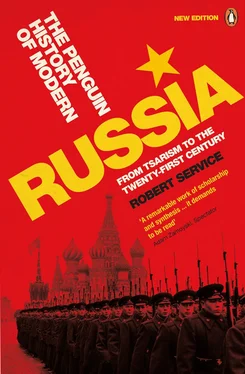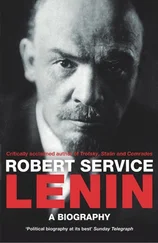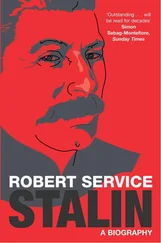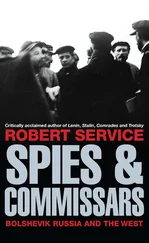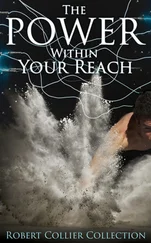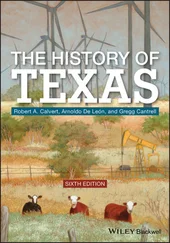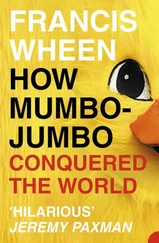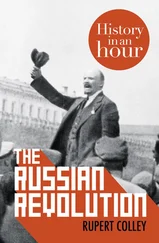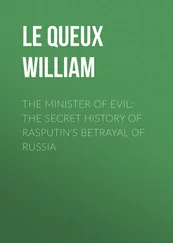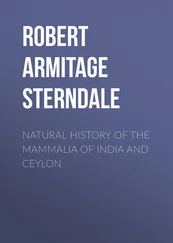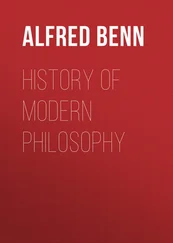Even so, revolts occurred at the end of the Civil War and at the end of the 1920s, and urban disturbances took place sporadically in the mid-1960s, the 1970s and the late 1980s. But, on the whole, rebellion was rare. This infrequency resulted not only from the state’s ruthless violence but also from its provision of primitive social security. There was a tacit contract between the regime and society which endured to the end of the communist era, a contract which has proved difficult for the country’s subsequent government to tear up.
Russians and other peoples of the USSR had always had ideas of social justice and been suspicious of their rulers, and the Soviet regime’s repressiveness fortified this attitude. They also noted the communist party’s failure, from one generation to another, to fulfil its promises. The USSR never became a land of plenty for most of its citizens, and the material and social benefits bestowed by communism could not camouflage the unfairnesses that pervaded society. In time, moreover, a country of peasants was turned into an industrial, urban society. As in other countries, the inhabitants of the towns directed an ever greater cynicism at politicians. The increasing contact with Western countries added to the contempt felt for an ideology which had never been accepted in its entirety by most citizens. Russia, which was hard enough to tame in 1917–1918, had become still less easy to hold in subjection by the late 1980s.
The rulers anyway faced problems which were not simply the consequence of 1917. The heritage of the more distant past also bore down upon them. Russia’s size, climate and ethnic diversity greatly complicated the tasks of government. It also lagged behind its chief competitors in industrial and technological capacity; it was threatened by states to the West and the East and its frontiers were the longest in the world. Arbitrary state power was a dominant feature in public life. Official respect for legality was negligible and the political and administrative hierarchy was over-centralized. Russia, furthermore, had an administration which barely reached the lower social classes on a day-to-day basis. Most people were preoccupied by local affairs and were unresponsive to appeals to patriotism. Education was not widely spread; civic integration and inter-class tolerance were minimal. The potential for inter-ethnic conflict, too, was growing. Social relationships were extremely harsh, often violent.
Lenin and the communists came to power expecting to solve most of these problems quickly. Their October Revolution was meant to facilitate revolution throughout Europe and to re-set the agenda of politics, economics and culture around the globe. To their consternation, revolution did not break out across Europe and the central party leaders increasingly had to concentrate on problems inherited from the tsars.
In reality the behaviour of Lenin and his successors often aggravated rather than resolved the problems. Their theories even before the October Revolution had an inclination towards arbitrary, intolerant and violent modes of rule. While proclaiming the goal of a society devoid of oppression, they swiftly became oppressors to an unprecedented degree of intensity. Soviet communists, unconsciously or not, fortified the country’s traditional political postures: the resort to police-state procedures, ideological persecution and anti-individualism derived as much from tsarist political and social precedents as from Marxism-Leninism. What is more, the concern that Russia might lose its status as a Great Power was as important to Stalin and his successors as to the Romanov dynasty. The appeal to Russian national pride became a regular feature of governmental pronouncements. Office-holders thought of themselves as Marxist-Leninists; but increasingly they behaved as if Russia’s interests should have precedence over aspirations to worldwide revolution.
Russia, of course, was not the entire USSR and not all Soviet citizens were Russians. Furthermore, it was party policy throughout the USSR’s history to transmute existing national identities into a sense of belonging to a supranational ‘Soviet people’. This was part of a general endeavour by the state to eradicate any organizations or groupings independent of its control. The central politicians could not afford to let Russian national self-assertiveness get out of hand.
But what on earth was Russia? And what was Russia’s part in the Soviet Union? These are questions which are much less easy to answer than they superficially appear. The borders of the Russian republic within the USSR were altered several times after 1917. Nearly every redefinition involved a loss of territory to the USSR’s other republics. The status of ethnic Russians, too, changed under several political leaderships. Whereas Lenin was wary of Russian national self-assertiveness, Stalin sought to control and exploit it for his political purposes; and the Soviet communist leadership after Stalin’s death, despite coming to rely politically upon the Russians more than upon other nationalities in the Soviet Union, never gave them outright mastery. Nor was Russian culture allowed to develop without restriction: the Orthodox Church, peasant traditions and a free-thinking intelligentsia were aspects of Mother Russia which no General Secretary until the accession of Gorbachëv was willing to foster. Russian national identity was perennially manipulated by official interventions.
For some witnesses the Soviet era was an assault on everything fundamentally Russian. For others, Russia under Stalin and Brezhnev attained its destiny as the dominant republic within the USSR. For yet others neither tsarism nor communism embodied any positive essence of Russianness. The chances are that Russian history will remain politically sensitive. This is not simply a case of public figures whipping up debate. Russians in general are interested in discussions of Nicholas II, Lenin, Stalin and Gorbachëv; and the past and the present are enmeshed in every public debate.
Russia is under the spotlight in this book. But the history of Russia is inseparable from the history of the Russian Empire, the Soviet Union and the Commonwealth of Independent States. It would be artificial to deal exclusively with Russian themes in those many cases in which these themes are knotted together with the situation in adjacent areas. My rule of thumb has been to omit from the account those events and situations that had little impact upon ‘Russia’ and affected only the non-Russian areas of the Russian Empire, the Soviet Union and the Commonwealth of Independent States. On the other hand, the chapters are not designed as an account of the Russian Empire, the Soviet Union and the Commonwealth of Independent States with the ‘Russian factor’ being addressed only glancingly. For the general history of this huge area of Europe and Asia can be understood only when Russia’s history is thrown into relief.
In still broader terms, the plan is to treat Soviet history as a unitary period and to explain the inner strengths and strains of the USSR. Recently it has become fashionable to assert that communism in Russia could easily have been eradicated at any moment in its seventy years of existence. This is just as exaggerated a notion as the earlier conventional notion that the regime was impervious to any kind of domestic or foreign pressure.
But what kind of regime was the USSR? Continuities with the tsarist years are examined in the following chapters; so, too, are the surviving elements of the communist order in post-Soviet Russia. The shifting nature of Russian national identity is also highlighted. And an account is offered not only of the central political leadership but also of the entire regime as well as of the rest of society. This means that the focus is not confined to leading ‘personalities’ or to ‘history from below’. Instead the purpose is to give an analysis of the complex interaction between rulers and ruled, an interaction that changed in nature over the decades. Not only politics but also economics, sociology and culture are examined. For it is an organizing principle of the book that we can unravel Russia’s mysteries only by taking a panoramic viewpoint.
Читать дальше
